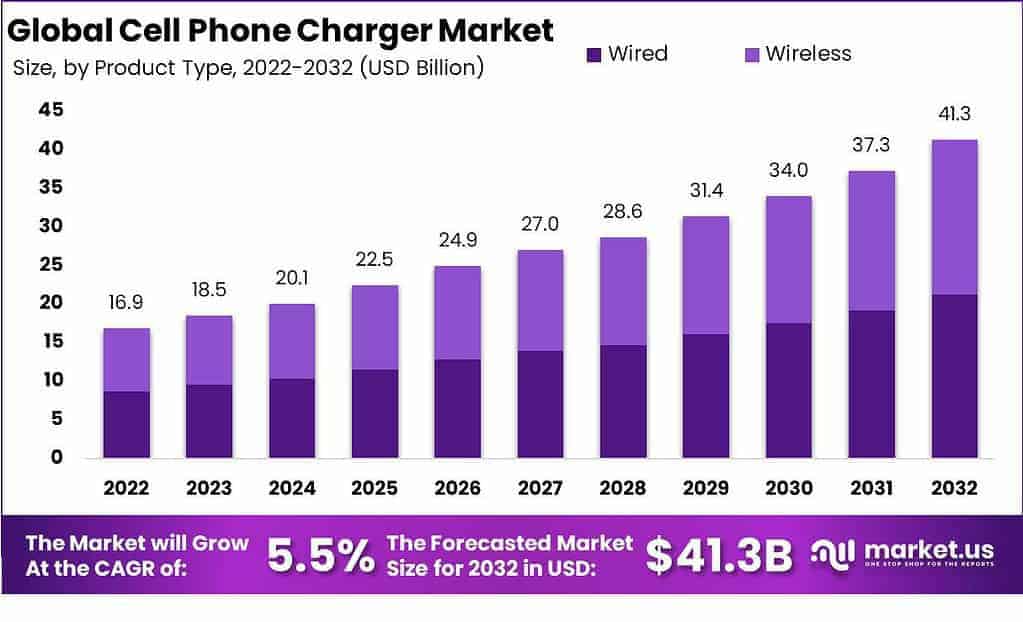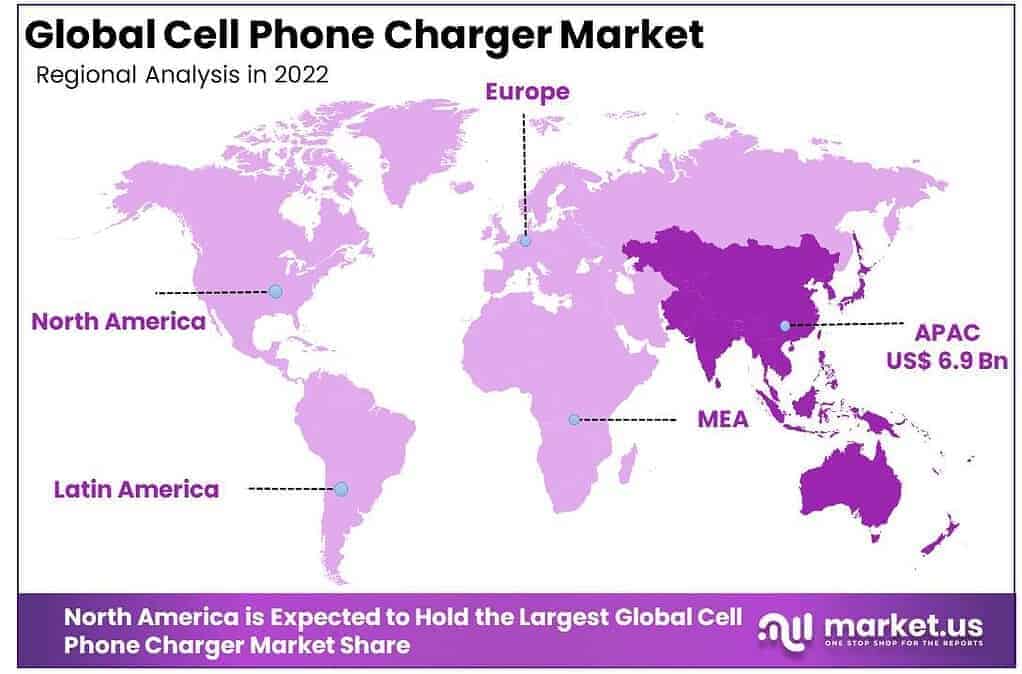Table of Contents
Introduction
New York, NY – March 11 , 2025 – The Global Cell Phone Charger Market is projected to grow from USD 16.9 billion in 2022 to USD 41.3 billion by 2032, registering a significant compound annual growth rate (CAGR) of 5.5% during the forecast period.
The cell phone charger is an essential power accessory designed to recharge mobile phone batteries through various charging technologies, including wired (USB Type-C, Micro USB, Lightning) and wireless (Qi-standard) options. The cell phone charger market encompasses the production, distribution, and sales of charging solutions catering to consumer electronics, with a growing focus on fast-charging and wireless technologies.
Market growth is driven by increasing smartphone penetration, rapid advancements in battery technology, and rising consumer demand for efficient charging solutions. The proliferation of high-performance smartphones with larger batteries has fueled the demand for fast-charging solutions, while sustainability trends have encouraged the development of eco-friendly and energy-efficient chargers.
Moreover, government regulations mandating standardization, such as the European Union’s push for USB-C chargers, are shaping market dynamics. The demand for cell phone chargers is further bolstered by the increasing adoption of wireless charging, the expansion of 5G technology, and the growing use of multiple electronic devices per consumer, necessitating multi-device charging solutions. Additionally, the surge in mobile gaming and high-power-consuming applications has intensified the need for fast-charging technologies like GaN (Gallium Nitride) chargers.
Opportunities in the market include the development of universal charging solutions, smart chargers with adaptive power distribution, and sustainable charging technologies using solar or renewable energy sources. Manufacturers focusing on innovation in compact, high-efficiency designs and compatibility across multiple brands are expected to gain a competitive edge. The market’s trajectory is poised for sustained growth, driven by evolving consumer preferences, technological advancements, and regulatory frameworks that promote universal and sustainable charging solutions.

Key Takeaways
- The global cell phone charger market is expected to expand from USD 16.9 billion in 2022 to USD 41.3 billion by 2032, registering a CAGR of 5.5% during the forecast period.
- Wired chargers dominate the market, holding a 51.0% revenue share in 2022.
- Offline distribution channels are projected to maintain a dominant position, accounting for at least 80.0% of total market share over time.
- General chargers are anticipated to hold the largest share of 52.0% throughout the forecast period.
- The Asia-Pacific region accounted for 41.4% of total market revenue in 2022, leading the global market.
Report Scope
| Report Features | Description |
|---|---|
| Market Value (2023) | USD 18.5 Bn |
| Forecast Revenue (2032) | USD 41.3 Bn |
| CAGR (2023-2032) | 5.5% |
| Segments Covered | By Product Type (Wired, Wireless), By Distribution Channel (Offline & Online), By Application (Power Bank, General Charger) |
| Competitive Landscape | Momax, Yoobao, HONGYI, SIYOTEAM, AOHAI, LG Electronics, Hosiden, Rayovac, Aigo, MC power, ARUN, Mipow, Salcomp, Samsung, Sinoele, Scud, PNY, Other Key Players |
Emerging Trends
- Universal Adoption of USB-C Ports: The European Union’s Directive 2022/2380 mandates that, starting December 28, 2024, most electronic devices, including mobile phones, must feature USB-C charging ports. This regulation aims to reduce e-waste and standardize charging interfaces across devices.
- Advancements in Wireless Charging: Innovations in wireless charging technology are enabling longer charging distances and the ability to charge multiple devices simultaneously. Future developments may allow devices to charge simply by being in proximity to a charging field, eliminating the need for direct contact with charging pads.
- Integration of GaN Technology: The incorporation of Gallium Nitride (GaN) in chargers allows for higher efficiency and faster charging speeds in more compact designs. This advancement addresses the growing consumer demand for quick and portable charging solutions.
- Rise of Eco-Friendly Chargers: There is an increasing emphasis on sustainable materials and energy-efficient designs in charger manufacturing. Companies are developing chargers with reduced environmental impact to align with global sustainability goals.
- Emergence of Swappable Battery Systems: Innovative charging solutions, such as Swippitt’s system unveiled at CES 2025, offer users the ability to swap out their phone’s battery case with a fully charged one in seconds, providing an alternative to traditional charging methods.
Top Use Cases
- Fast Charging for High-Capacity Batteries: As smartphones with larger batteries become common, fast chargers are essential to reduce downtime and enhance user convenience.
- Wireless Charging in Public Spaces: The integration of wireless charging stations in public areas like airports, cafes, and hotels offers users convenient charging options without the need for cables.
- Portable Power Banks for On-the-Go Charging: Portable chargers provide users with the flexibility to charge their devices anywhere, addressing the need for mobility and continuous connectivity.
- Multi-Device Charging Hubs: Charging stations capable of powering multiple devices simultaneously cater to households and workplaces with numerous gadgets, streamlining the charging process.
- Eco-Friendly Charging Solutions: Chargers designed with sustainable materials and energy-efficient technologies appeal to environmentally conscious consumers seeking to reduce their carbon footprint.
Major Challenges
- Compatibility Issues: Despite standardization efforts, variations in charging protocols can lead to incompatibility between chargers and devices, causing inconvenience for users.
- E-Waste Generation: The rapid turnover of electronic devices contributes to significant electronic waste, with discarded chargers adding to environmental concerns.
- Safety Risks with Counterfeit Chargers: The proliferation of counterfeit chargers poses safety hazards, including risks of overheating, electrical shocks, and device damage.
- Cybersecurity Threats: Malicious charging cables can compromise device security, leading to data breaches and unauthorized access. Users are advised to use trusted chargers to mitigate these risks.
- High Costs of Advanced Chargers: Chargers incorporating cutting-edge technologies, such as GaN, often come with higher price tags, potentially limiting their accessibility to cost-sensitive consumers.
Top Opportunities
- Development of Universal Chargers: Creating chargers compatible across various brands and devices can simplify the user experience and reduce the need for multiple chargers.
- Expansion of Wireless Charging Infrastructure: Investing in public wireless charging stations can enhance user convenience and promote the adoption of wireless charging technologies.
- Innovations in Fast-Charging Technologies: Advancing fast-charging capabilities to reduce charging times can meet consumer demand for quick and efficient power solutions.
- Promotion of Sustainable Charging Solutions: Developing eco-friendly chargers made from recyclable materials can appeal to environmentally conscious consumers and support sustainability initiatives.
- Integration of Smart Features: Incorporating smart technologies, such as adaptive charging and energy monitoring, can enhance charger functionality and provide added value to users.
Key Player Analysis
The Global Cell Phone Charger Market in 2024 is characterized by intense competition among key players, with both established brands and emerging companies vying for market share. Samsung, LG Electronics, and Salcomp continue to dominate due to their strong brand presence, technological advancements, and extensive distribution networks. Momax, Yoobao, and Mipow are leveraging innovation in fast-charging and wireless charging solutions, catering to the growing consumer demand for convenience and efficiency.
AOHAI and Hosiden maintain a strong position as key suppliers to major smartphone manufacturers, reinforcing their significance in the supply chain. HONGYI, SIYOTEAM, and ARUN are gaining traction in cost-sensitive markets, offering affordable yet reliable charging solutions. Meanwhile, Scud, PNY, and Sinoele are focusing on high-capacity power banks and fast-charging adapters, addressing the increasing demand for power-efficient solutions. With rising smartphone penetration and evolving charging technologies, these players are expected to drive market growth through innovation, partnerships, and strategic expansions.
Market Key Players
- Momax
- Yoobao
- HONGYI
- SIYOTEAM
- AOHAI
- LG Electronics
- Hosiden
- Rayovac
- Aigo
- MC power
- ARUN
- Mipow
- Salcomp
- Samsung
- Sinoele
- Scud
- PNY
- Other Key Players
Regional Analysis
Asia-Pacific Leads Cell Phone Charger Market with Largest Market Share of 41.4% in 2024
The Asia-Pacific region dominates the global cell phone charger market, holding the largest market share of 41.4% in 2024. This dominance is attributed to the region’s extensive smartphone penetration, rapid urbanization, and growing demand for fast-charging solutions. The market in Asia-Pacific is valued at USD 6.9 billion, driven by increasing consumer electronics adoption, expanding e-commerce sales, and advancements in battery technologies.
Countries such as China, India, and Japan serve as key growth drivers, with China leading in charger production due to its strong manufacturing base and technological advancements. The surge in demand for wireless chargers, Type-C fast chargers, and eco-friendly charging solutions further supports regional market expansion. The presence of leading smartphone manufacturers and government initiatives promoting green energy contribute to sustained growth.

Recent Developments
- In January 5, 2025 Belkin, a trusted name in consumer electronics for four decades, unveiled a range of new products in its Mobile Power, Audio, and Future Ventures categories. The launch highlights Belkin’s commitment to innovation, quality, and sustainability. These products are being showcased at CES Unveiled Las Vegas, the official media event of CES 2025.
- In January 9, 2025 Huawei introduced the Top 10 Trends of the Charging Network Industry 2025 under the theme “Jointly Charging the Road Ahead.” Wang Zhiwu, President of Huawei Smart Charging Network Domain, provided an in-depth analysis of industry advancements and the future trajectory of charging network technology.
- In July 28, 2023 LG Electronics (LG) published its 2022-2023 Sustainability Report, outlining its progress and future strategy based on six key objectives aligned with its ESG vision, “Better Life for All.” The company prioritizes two main areas: ‘3Cs’—carbon neutrality, circularity, and clean technology—and ‘3Ds’—inclusive design, a positive work environment, and diversity.
- In 2025 Anker introduced a 140W wall charger at CES 2025, featuring an innovative design with four USB ports positioned on the underside. This design enhances stability, ensuring the charger remains securely plugged in even with multiple cables connected. It is also the first Anker wall charger with an integrated display showing real-time power output for each port.
Conclusion
The global cell phone charger market is set for steady growth, driven by increasing smartphone usage, advancements in charging technologies, and rising demand for efficient power solutions. The shift toward fast-charging, wireless options, and eco-friendly designs is shaping market trends, with regulatory policies promoting standardization. Manufacturers focusing on innovation, universal compatibility, and sustainability are well-positioned for competitive advantage. Expansion in emerging markets, the adoption of 5G, and the rise of multi-device users further contribute to market development. The industry’s future lies in smart, adaptive, and energy-efficient charging solutions catering to evolving consumer needs.
Discuss Your Needs With Our Analyst
Please share your requirements with more details so our analyst can check if they can solve your problem(s)





